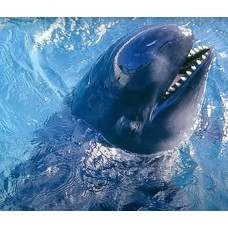Latin name
Pseudorca crassidens
Other names
Pseudorca crassidens
Identification
The head is rounded, with a melon-shaped forehead. The body is elongated. The upper jaw is longer than the lower. The body is more robust than that of other dolphins. There are 8-11 teeth on each side of the jaw. The length of the skull is 55-59 cm for females and 58-65 cm for males. The number of vertebrae is 47-52: 7 cervical, 10 thoracic, 11 lumbar, and 20-23 caudal. They have 10 pairs of ribs.
Features of fish fins
The dorsal fin is sickle-shaped, protruding from the center of the back, the pectoral fins are sharp. The dorsal fin can reach 18-40 cm in height. The length of the fin is about ten times less than the length of the body. It usually has a well-defined notch in the middle, and the ends of the fin are sharp.
Fish colouring
Overall coloration is black or dark gray with a white stripe on the ventral side. Some individuals have lighter gray coloration on the head and sides.
Distribution
They are found throughout the Atlantic, Pacific and Indian Oceans. In the north they do not swim north of 50°N, in the south south of 52°S.
This species is found in New Zealand, Peru, Argentina, South Africa, the northern Indian Ocean, Australia, the Indo-Malay Archipelago, the Philippines and the northern Yellow Sea. Smaller False killer whale have been found in the Sea of Japan, the coastal provinces of British Columbia, the Bay of Biscay, the Red Sea, and the Mediterranean Sea. Some individuals live in the Gulf of Mexico and around the Hawaiian Islands.
Habitat
They live in tropical and temperate oceans. They sometimes swim to the shore, but prefer to stay in deep water. They can dive to depths of up to 2 km.
Size
Adult males reach 3.7-6.1 m in length, adult females 3.5-5 m. Body mass varies from 917 to 1842 kg. Newborns are 1.5-1.9 m long and weigh about 80 kg.
Behavior
They live in groups of up to several hundred dolphins of different ages. Such large groups are usually subdivided into smaller groups. Their average number is 10-30 individuals.
To communicate with each other, they use echolocation in the range of 20 to 60 kHz, sometimes 100-130 kHz. May make sounds such as whistles, squeaks, or less distinct pulsing sounds. Their shrill whistles can be heard from depths of 200 meters.
Food and feeding habits
False killer whales are carnivorous and feed mainly on fish and squid, for which they move quite fast. Sometimes they may eat marine mammals such as seals or sea lions. Salmon (Oncorhynchus), mackerel (Sarda lineolata), herring (Pseudosciana manchurica) and perch (Lateolabrax japonicus) form the basis of their diet.
Reproduction
They breed throughout the year, peaking in late winter and early spring. Pregnancy lasts 11-15.5 months. Only one calf is born. It stays with the mother for 18-24 months and is weaned at the same age. Sexual maturity occurs at 8-10 years for males and 8-11 years for females. After giving birth, females do not give birth for an average of 6.9 years. Cubs are capable of independent movement immediately after birth. After weaning, they usually remain in the same social group as their mother.
In the wild, males live an average of 57.5 years and females 62.5 years. Captive life expectancy is unknown.
Fishing
In Japan, these dolphins are used as a food source, just as they are killed for meat and fat in the Caribbean.
Relationship with a person
It is very common for false killer whales to strand in large numbers. Mass strandings have been recorded on beaches in Scotland, Ceylon, Zanzibar and along the coast of the UK.
| Classification | |
| Phylum | Chordata |
| Class | Mammalia |
| Squad | Artiodactyla |
| Family | Delphinidae |
| Genus | Pseudorca |
| Species | P. crassidens |
| Features | |
| Conservation status | Near Threatened |
| Habitat | Pelagic |
| Life span, years | 62,5 |
| Maximum body weight, kg | 1842 |
| Maximum length, cm | 610 |
| Sailing speed, m/s | No information |
| Threat to people | Edible |
| Way of eating | Predator |
False killer whale
Tags: false killer whale



